On the evening of 4 August 1964, a nationwide television audience saw their “grim-faced” president, Lyndon B. Johnson, announce that North Vietnamese torpedo boats had attacked two U.S. destroyers in the Gulf of Tonkin, off North Vietnam’s coast. This was the second such attack in three days, the president said.
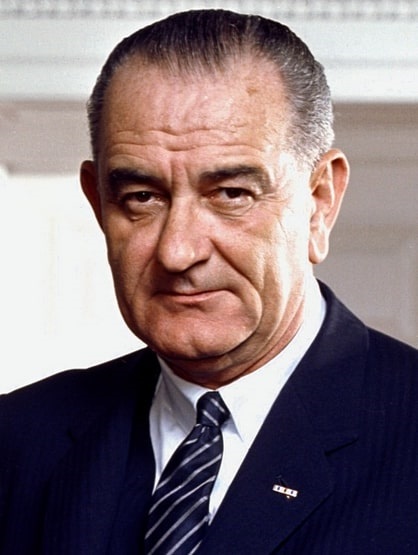
In response, Johnson ordered air strikes against North Vietnamese gunboats and their support facilities. That retaliation (code-named “Operation Pierce Arrow”) occurred the next day, August 5. According to Wikipedia:
“The operation consisted of 64 strike sorties of aircraft from the aircraft carriers USS Ticonderoga and USS Constellation against the torpedo boat bases of Hon Gai, Loc Chao, Quang Khe, and Phuc Loi, and the oil storage depot at Vinh. The U.S. lost two aircraft to anti-aircraft fire, with one pilot killed, Lieutenant Richard Sather, piloting an A-1 Skyraider. Another, Lt. (jg) Everett Alvarez Jr., an A-4 Skyhawk pilot, became the first U.S. Navy Prisoner of War in Vietnam. Pilots estimated that the Vinh raid destroyed 10 percent of North Vietnam’s entire petroleum storage, together with the destruction of or damage to 29 P-4 torpedo boats or gunboats.”
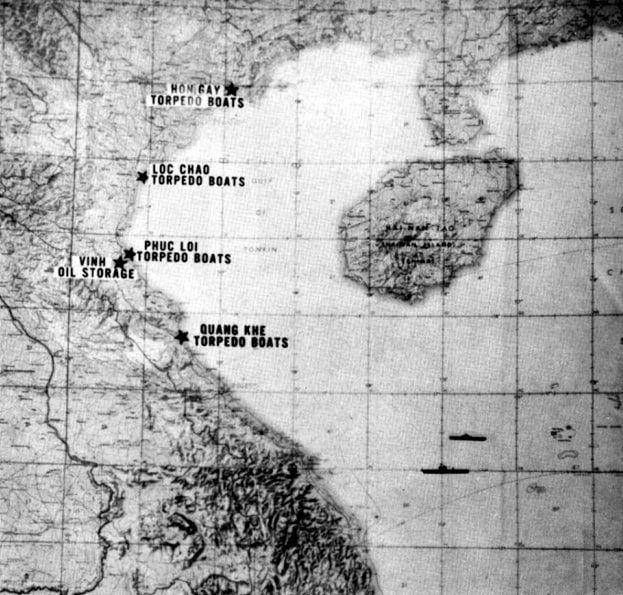
In his nationwide address, Johnson also requested a resolution from Congress that was quickly passed on August 7 – the Gulf of Tonkin Resolution – giving Johnson legal authority to attack North Vietnam, entering America into a new phase of direct participation in the Vietnam War.
However, that August 4 attack by North Vietnamese torpedo boats never happened; although he did not know it at the time, Johnson was not telling the truth to the American public in his televised speech.
The first battle, on August 2, most certainly did happen: the U.S. destroyer Maddox and four jets from the carrier Ticonderoga fought with three North Vietnamese PT boats in the Gulf of Tonkin. All three North Vietnamese boats were damaged and they suffered ten casualties, including four dead. The Americans suffered no casualties and only slight damage.
The Maddox was in international waters at the time of the battle, conducting electronic surveillance of North Vietnamese military communications to aid the South Vietnamese army. Although initial reports claimed the North Vietnamese fired first, leading to American charges of an “unprovoked attack,” the Maddox actually fired the first three shots of the engagement as a warning to the advancing gunboats.
Two days later the Maddox, this time joined by the U.S. destroyer C. Turner Joy, reported that it was again under attack by torpedo boats in the Gulf of Tonkin. There were a reported six North Vietnamese PT boats this time, and two were reported sunk. During the battle both destroyers fired their guns repeatedly and undertook evasive maneuvers for over two hours, but they were reacting to faulty radar and sonar readings caused by storm conditions. There were no enemy gunboats out there.

President Johnson had resisted suggestions in the past by Defense Secretary Robert S. McNamara to bomb North Vietnam, and he had been telling the American people the U.S. would not engage in open warfare with the North Vietnamese. After the initial reports of the August 4 “battle,” the U.S. commander in the Gulf of Tonkin, Captain John J. Herrick, alerted Washington that he and others were no longer certain an attack had actually occurred.
McNamara read the later reports and knew the attack claim was doubtful, but did not tell the president before he went on the air to address the public. At the time of his televised address, Johnson thought he had the latest intelligence and believed the claims he told the American people.
The following three newspaper articles are about the Gulf of Tonkin Incident, the American retaliatory air strikes, and President Johnson’s address to the nation. The first is an editorial that appeared the day of the second “battle,” before reports of the attack had reached the press.
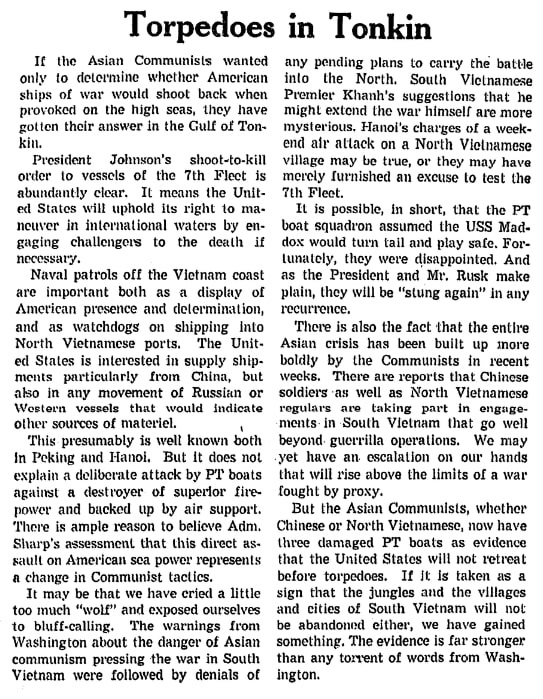
Here is a transcription of this article:
Torpedoes in Tonkin
If the Asian Communists wanted only to determine whether American ships of war would shoot back when provoked on the high seas, they have gotten their answer in the Gulf of Tonkin.
President Johnson’s shoot-to-kill order to vessels of the 7th Fleet is abundantly clear. It means the United States will uphold its right to maneuver in international waters by engaging challengers to the death if necessary.
Navy patrols off the Vietnam coast are important both as a display of American presence and determination, and as watchdogs on shipping into North Vietnamese ports. The United States is interested in supply shipments particularly from China, but also in any movement of Russian or Western vessels that would indicate other sources of materiel.
This presumably is well known both in Peking and Hanoi. But it does not explain a deliberate attack by PT boats against a destroyer of superior firepower and backed up by air support. There is ample reason to believe Adm. Sharp’s assessment that this direct assault on American sea power represents a change in Communist tactics.
It may be that we have cried a little too much “wolf” and exposed ourselves to bluff-calling. The warnings from Washington about the danger of Asian communism pressing the war in South Vietnam were followed by denials of any pending plans to carry the battle into the North. South Vietnamese Premier Khanh’s suggestions that he might extend the war himself are more mysterious. Hanoi’s charges of a weekend air attack on a North Vietnamese village may be true, or they may have merely furnished an excuse to test the 7th Fleet.
It is possible, in short, that the PT boat squadron assumed the USS Maddox would turn tail and play safe. Fortunately, they were disappointed. And as the President and Mr. Rusk make plain, they will be “stung again” in any recurrence.
There is also the fact that the entire Asian crisis has been built up more boldly by the Communists in recent weeks. There are reports that Chinese soldiers as well as North Vietnamese regulars are taking part in engagements in South Vietnam that go well beyond guerrilla operations. We may yet have an escalation on our hands that will rise above the limits of a war fought by proxy.
But the Asian Communists, whether Chinese or North Vietnamese, now have three damaged PT boats as evidence that the United States will not retreat before torpedoes. If it is taken as a sign that the jungles and the villages and cities of South Vietnam will not be abandoned either, we have gained something. The evidence is far stronger than any torrent of words from Washington.
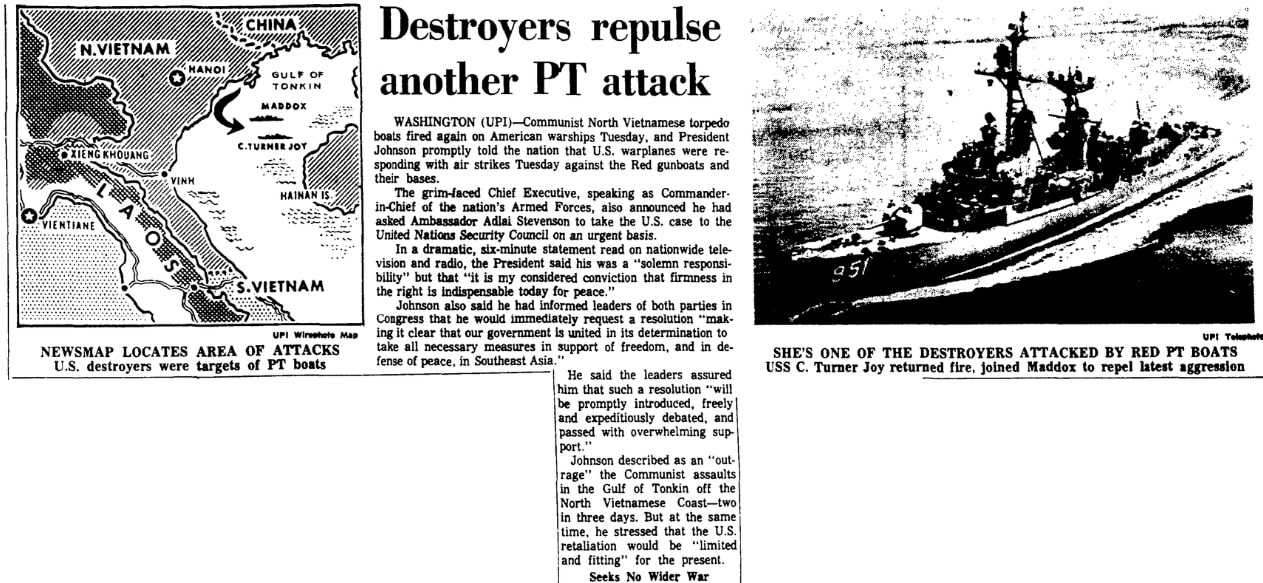
Here is a transcription of this article:
Destroyers Repulse Another PT Attack
Washington (UPI) – Communist North Vietnamese torpedo boats fired again on American warships Tuesday, and President Johnson promptly told the nation that U.S. warplanes were responding with air strikes Tuesday against the Red gunboats and their bases.
The grim-faced Chief Executive, speaking as Commander-in-Chief of the nation’s Armed Forces, also announced he had asked Ambassador Adlai Stevenson to take the U.S. case to the United Nations Security Council on an urgent basis.
In a dramatic, six-minute statement read on nationwide television and radio, the President said his was a “solemn responsibility” but that “it is my considered conviction that firmness in the right is indispensable today for peace.”
Johnson also said he had informed leaders of both parties in Congress that he would immediately request a resolution “making it clear that our government is united in its determination to take all necessary measures in support of freedom, and in defense of peace, in Southeast Asia.”
He said the leaders assured him that such a resolution “will be promptly introduced, freely and expeditiously debated, and passed with overwhelming support.”
Johnson described as an “outrage” the Communist assaults in the Gulf of Tonkin off the North Vietnamese Coast – two in three days. But at the same time, he stressed that the U.S. retaliation would be “limited and fitting” for the present.
Seeks No Wider War
Obviously speaking to the Communists, he said:
“We Americans know, although others appear to forget, the risk of spreading conflict. We still seek no wider war.”
The President’s announcement came at 11:35 p.m. EDT, about 13 hours after North Vietnamese PT boats attacked the U.S. destroyers Maddox and C. Turner Joy in international waters of the storm-tossed gulf.
The destroyers repulsed the attack after a three-hour battle in which two of the six marauding gunboats were believed to have been sunk and two others damaged. There were no American casualties or damage.
Sunday Incident
Only last Sunday, the Maddox was attacked in the same waters by three Soviet-built North Vietnamese PT boats. One of the Red vessels was believed sunk and the other two were crippled under fire from the Maddox and jet fighters from the carrier Ticonderoga.
Shortly before Tuesday’s attack, the State Department announced it had sent a stern diplomatic protest to the Hanoi government warning of “grave consequences” if any new assaults were mounted.
The President’s statement, coming after a series of crisis talks with high military, diplomatic and legislative leaders, won the approval of Republican presidential candidate Barry M. Goldwater.
Johnson had telephoned the Arizona senator at his vacation retreat in Southern California and read him the statement saying “it is the only thing he can do under the circumstances.”
Nixon Arrives
And former Vice President Richard M. Nixon, arriving in Washington, called for “decisive action” in which the President should have the support of both parties in an election year.
In his brief statement, the President signaled a heavy diplomatic campaign to impress the world with the seriousness with which he considered “repeated acts of violence” against U.S. Armed Forces.
He said, “repeated acts of violence against the armed forces of the United States must be met not only with alert defense but with positive reply.”
That positive reply, he said, came even as he spoke with U.S. air strikes against the Red PT boats and their “supporting facilities” in North Viet Nam.
It was understood that by this, the President meant the ports from which the gunboats have been operating were under air attack.
Crisis Atmosphere
Tuesday’s naval engagement plunged official Washington into a crisis atmosphere and touched off a round of White House conferences.
When word of the assault reached Washington, the President immediately called the top-secret Security Council back into session, hours after another, previously scheduled session. A half-hour later, at 6:45 p.m. EDT, he called in 16 ranking Democrats and Republicans from the House and Senate for a briefing.
Describing the situation for them for 90 minutes were Johnson, Secretary of State Dean Rusk, Defense Secretary Robert S. McNamara, Director John A. McCone of the Central Intelligence Agency (CIA), and Gen. Earle G. Wheeler, chairman of the Joint Chiefs of Staff.
About 15 minutes after the meeting broke up, White House Press Secretary George E. Reedy told newsmen that the President would deliver a statement in person “at an appropriate time tonight” and that it could be carried live on television and radio.
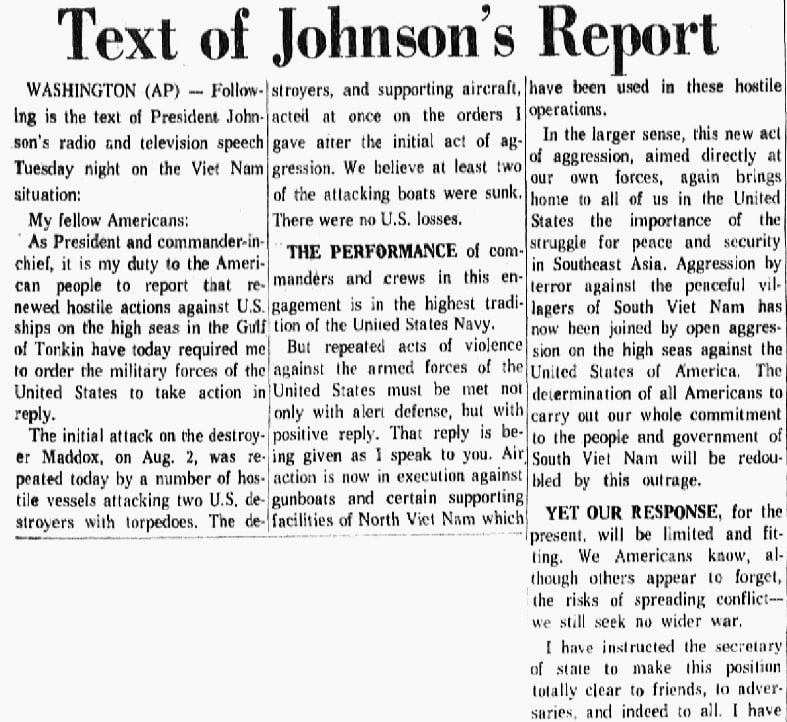
Here is a transcription of this article:
Text of Johnson’s Report
Washington (AP) – Following is the text of President Johnson’s radio and television speech Tuesday night on the Viet Nam situation:
My fellow Americans:
As President and commander-in-chief, it is my duty to the American people to report that renewed hostile actions against U.S. ships on the high seas in the Gulf of Tonkin have today required me to order the military forces of the United States to take action in reply.
The initial attack on the destroyer Maddox, on Aug. 2, was repeated today by a number of hostile vessels attacking two U.S. destroyers with torpedoes. The destroyers, and supporting aircraft, acted at once on the orders I gave after the initial act of aggression. We believe at least two of the attacking boats were sunk. There were no U.S. losses.
The performance of commanders and crews in this engagement is in the highest tradition of the United States Navy.
But repeated acts of violence against the armed forces of the United States must be met not only with alert defense, but with positive reply. That reply is being given as I speak to you. Air action is now in execution against gunboats and certain supporting facilities of North Viet Nam which have been used in these hostile operations.
In the larger sense, this new act of aggression, aimed directly at our own forces, again brings home to all of us in the United States the importance of the struggle for peace and security in Southeast Asia. Aggression by terror against the peaceful villagers of South Viet Nam has now been joined by open aggression on the high seas against the United States of America. The determination of all Americans to carry out our whole commitment to the people and government of South Viet Nam will be redoubled by this outrage.
Yet our response, for the present, will be limited and fitting. We Americans know, although others appear to forget, the risks of spreading conflict – we still seek no wider war.
I have instructed the secretary of state to make this position totally clear to friends, to adversaries, and indeed to all. I have instructed Ambassador (Adlai) Stevenson to raise this matter immediately and urgently before the Security Council of the United Nations.
Finally, I have met today with the leaders of both parties in the Congress of the United States, and I have informed them that I shall immediately request the Congress to pass a resolution making it clear that our government is united in its determination to take all necessary measures in support of freedom, and in defense of peace, in Southeast Asia. I have been given encouraging assistance by these leaders that such a resolution will be promptly introduced, freely and expeditiously debated and passed with overwhelming support.
And just a few minutes ago, I was able to reach Sen. Goldwater, and I am glad to report he has expressed his support of the statement I am making tonight.
It is a solemn responsibility to have to order even limited military action by forces whose overall strength is as vast and as awesome as those of the United States of America. But it is my considered conviction, shared throughout your government, that firmness in the right is indispensable today for peace. That firmness will always be measured. Its mission is peace.
Note: An online collection of newspapers, such as GenealogyBank’s Historical Newspaper Archives, is not only a great way to learn about the lives of your ancestors – the old newspaper articles also help you understand American history and the times your ancestors lived in, and the news they talked about and read in their local papers. Did any of your family serve in the Vietnam War? Please share your stories with us in the comments section.
Related Articles:
